Houseplants are wildly popular among growers of all ages. If you have children who are curious about indoor gardening or simply love plants, encouraging their interests by giving them some plants of their own is a great place to start.
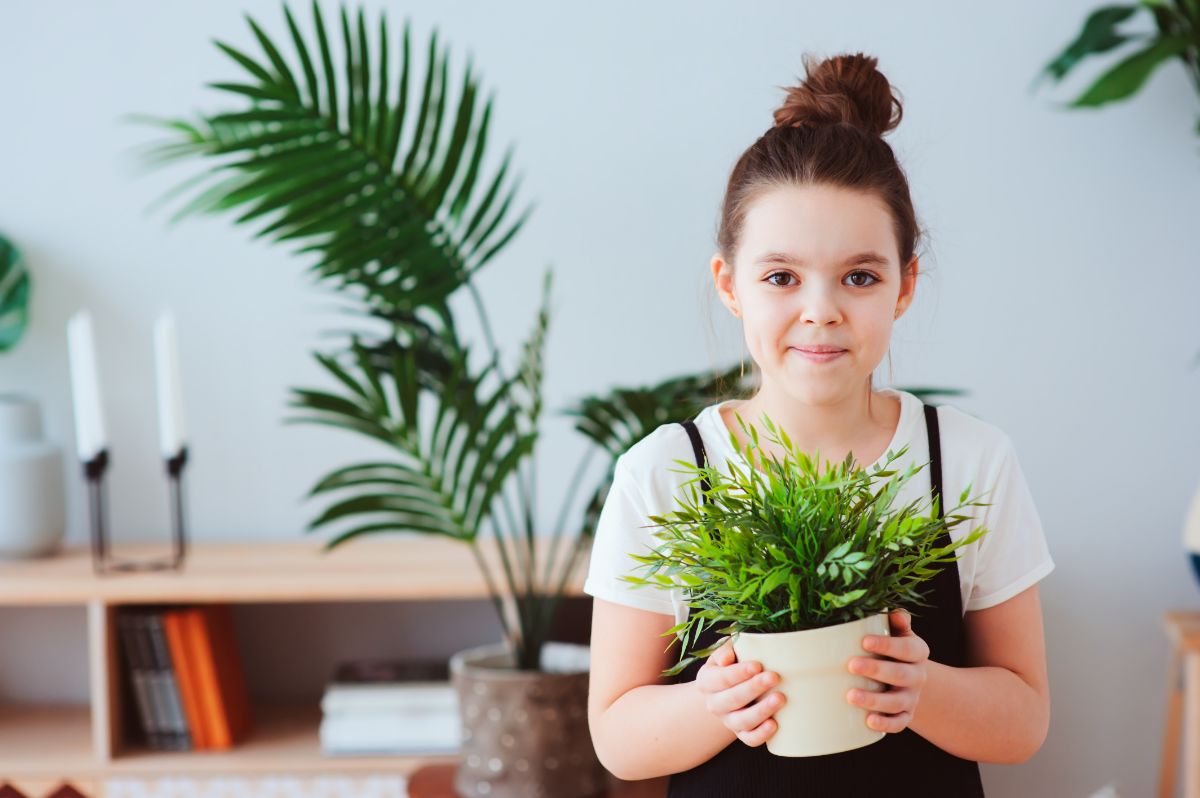
But if you’re looking for suggestions on easy care plants that are good for beginning gardeners, or you just want to find some funky looking plants you know your kids will love, we have plenty of suggestions for you!
In this guide, we’ll explore our absolute favorite plants for young gardeners. These plants are all relatively easy to care for and offer fun features like colorful blooms, wild shapes and much more. Read on and get inspired with these totally unique plants.
Jump to:
- 18 unique houseplants for kids
- 1. Panda plant (Kalanchoe tomentosa)
- 2. Ponytail palm (Beaucarnea recurvata)
- 3. Gerbera daisy (Gerbera jamesonii)
- 4. Moon cactus (Gymnocalycium mihanovichii)
- 5. Venus flytrap (Dionaea muscipula)
- 6. Avocado (Persea americana)
- 7. Croton (Codiaeum variegatum)
- 8. Pitcher plant (Nepenthes spp.)
- 9. Christmas cactus (Schlumbergera spp.)
- 10. Swedish ivy (Plectranthus verticillatus)
- 11. Pothos (Epipremnum aureum)
- 12. Snake plant (Dracaena trifasciata)
- 13. Lithops (Lithops spp.)
- 14. Dwarf citrus
- 15. Old man cactus (Cephalocereus senilis)
- 16. Nerve plant (Fittonia albivenis)
- 17. Spider plant (Chlorophytum comosum)
- 18. Herbs
- Frequently asked questions
- Summary
18 unique houseplants for kids

From tropical plants to low maintenance succulents, we’ve got plenty of beginner friendly plants to choose from. Below are our top picks for kid-friendly plants that we know you’ll love too!
1. Panda plant (Kalanchoe tomentosa)

| Plant type: | Panda plant |
| Light requirements: | Bright light |
| Watering requirements: | Low |
| Toxic if ingested? | Yes |
| Special features? | Super low maintenance; textured leaves. |
Panda plant has it all. It’s low maintenance and super easy to keep. But it’s also a pretty plant that is fun for the senses!
A variety of succulent, panda plant boasts slender stems and lance-shaped leaves that are coated in soft hairs that feel soft and furry when touched. The plant is named for its characteristic leaves, which are accentuated with warm, chocolatey brown dots at the leaf’s margins.
With minimal care requirements, panda plant is a good choice for beginning gardeners. It needs very little water and bright light and that’s about it. These plants can get spindly over time though, so try pruning them back on occasion to keep them looking bushier and give you lots of cuttings for propagation too!
2. Ponytail palm (Beaucarnea recurvata)
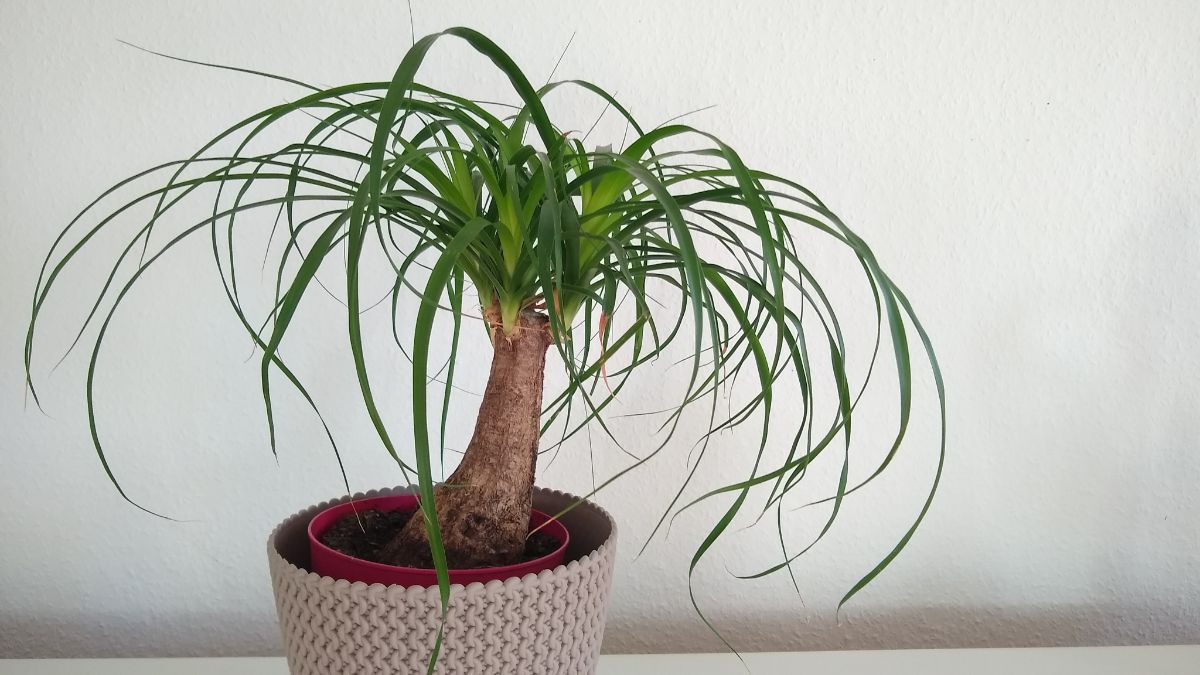
| Plant type: | Ponytail palm |
| Light requirements: | Bright light |
| Watering requirements: | Low |
| Toxic if ingested? | No |
| Special features? | Super low maintenance. |
Ponytail palms are funky, oddball plants that look like they came straight out of a Dr. Seuss story. Woody and bulbous trunks have evolved for excellent water storage, while slender, grass-like, curling leaves add just the right amount of contrast and an overall playful feel to this plant.
Thanks to its woody trunk, ponytail palm doesn’t need a lot of watering and should be treated just like other succulent plants. That means minimal watering, using a well-draining potting mix that’s appropriate for cacti and succulents and providing your plant with lots of bright sun.
3. Gerbera daisy (Gerbera jamesonii)
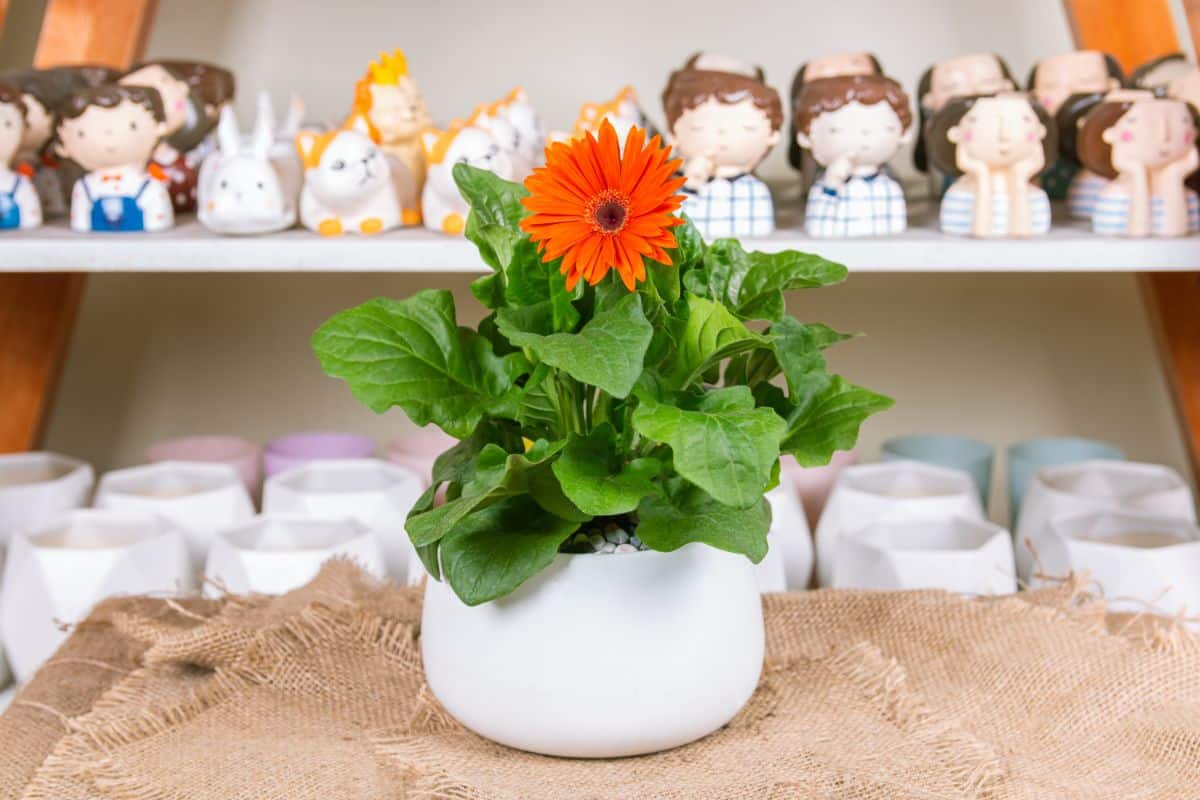
| Plant type: | Gerbera daisy |
| Light requirements: | Bright, indirect light |
| Watering requirements: | Moderate |
| Toxic if ingested? | No |
| Special features? | Big, colorful blooms. |
If your child loves lots of color and big, bold blooms, Gerbera daisies are an obvious choice. Also known as Transvaal daisies, these brilliant plants are naturally found in South Africa, but they make wonderful houseplants too.
Colorful, daisy-shaped blooms come in almost every color you could want: yellow, orange, pink… you name it! These plants are also pretty easy going and prefer regular and consistent watering.
Just be careful as Gerbera daisies can be more susceptible to common pests and pathogens than some other hardier species. Specifically, keep a look out for spider mites and powdery mildew on these plants. To prevent these issues, consider increasing humidity levels by adding a nearby humidifier and keep leaves dry with bottom watering.
4. Moon cactus (Gymnocalycium mihanovichii)
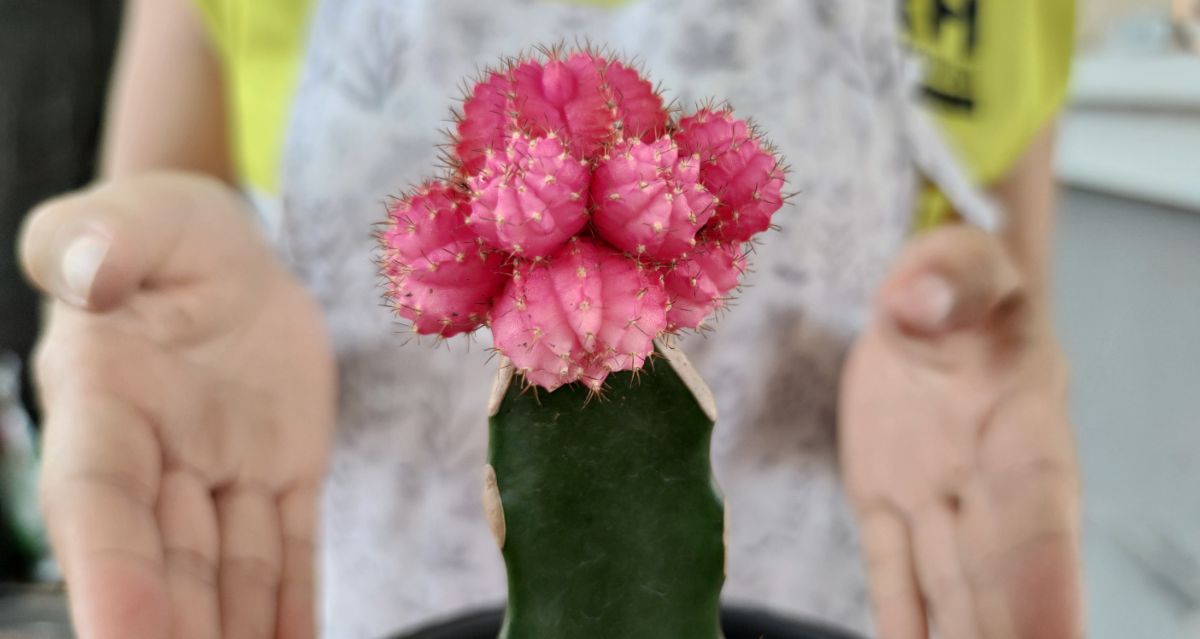
| Plant type: | Moon cactus |
| Light requirements: | Bright, indirect light |
| Watering requirements: | Low |
| Toxic if ingested? | No |
| Special features? | Lots of color; super low maintenance. |
Cacti are, in general, very low maintenance plants, so they’re perfect for children who are just learning how to garden. However, moon cacti are standouts in the cactus world, thanks to their bright colors and out of this world appearance.
Moon cacti actually don’t exist in nature. Instead, they are manmade inventions, created by grafting moon cacti on top of the stems of the dragon fruit cactus. This is done because colorful moon cacti are lacking in chlorophyll so they can’t photosynthesize on their own.
Fun plants to keep for the budding scientist in your life, moon cacti also need very little water. Just protect them from too much bright light as they may burn in direct sun.
If moon cacti aren’t your style, many other cactus varieties can be grown from seed, which can be an exciting indoor gardening project for little hands.
5. Venus flytrap (Dionaea muscipula)
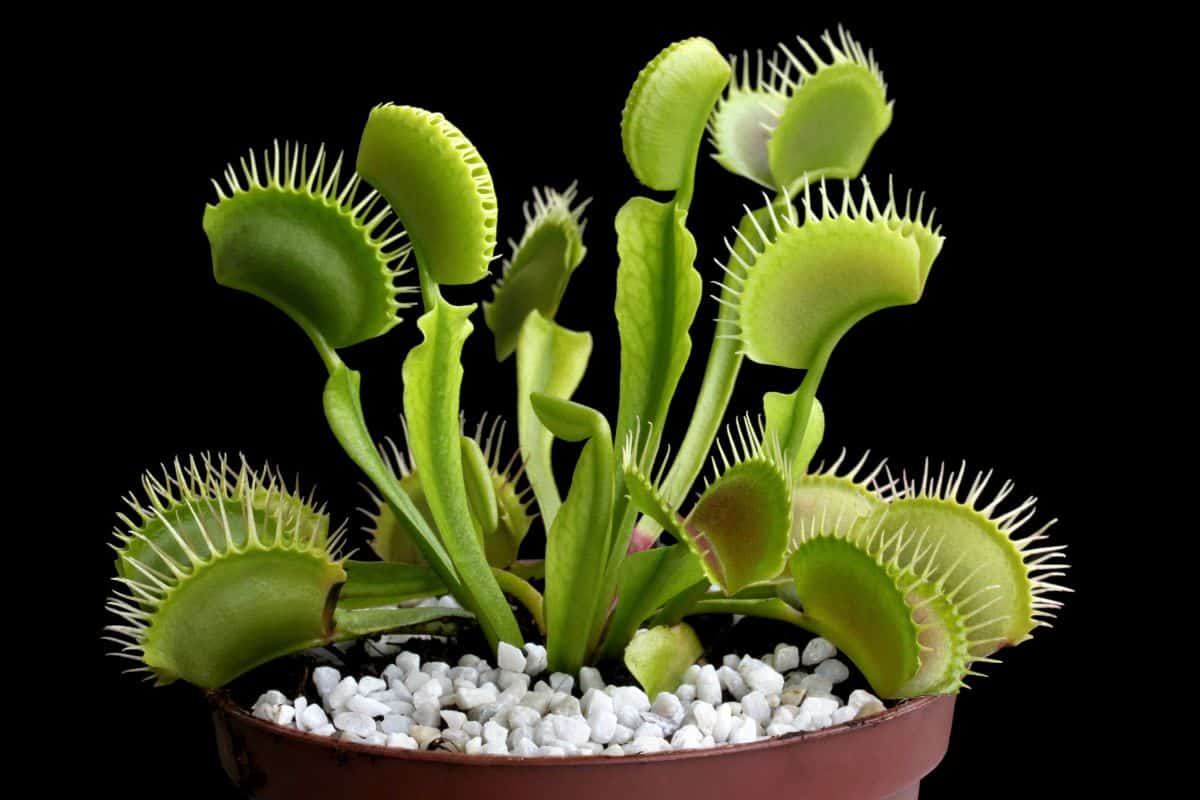
| Plant type: | Venus flytrap |
| Light requirements: | Bright light |
| Watering requirements: | High |
| Toxic if ingested? | No |
| Special features? | Carnivorous plant excels at natural pest control; traps move quickly for easy observation; good choice for terrariums. |
Venus flytraps are wildly unique plants. Looking like something from outer space, these carnivorous plants feature fast-moving traps atop their long and slender leaves. These traps are activated when insects touch the tiny hairs in the trap, causing the trap to snap closed on any hapless fly that happens to wander near.
Aside from being perfect for indoor pest control, Venus flytraps are just pleasant plants to keep over all. They move quickly enough to make observing them easy and they are just the right size for terrarium setups.
Just keep in mind that, in nature, these delicate plants live in nutrient poor boggy spots. That means that, as houseplants, they should never be fertilized and they should only be watered with distilled or rain water. Additionally, avoid activating the traps too much as this can deplete the plant’s energy and may cause your plant to weaken and die over time.
6. Avocado (Persea americana)
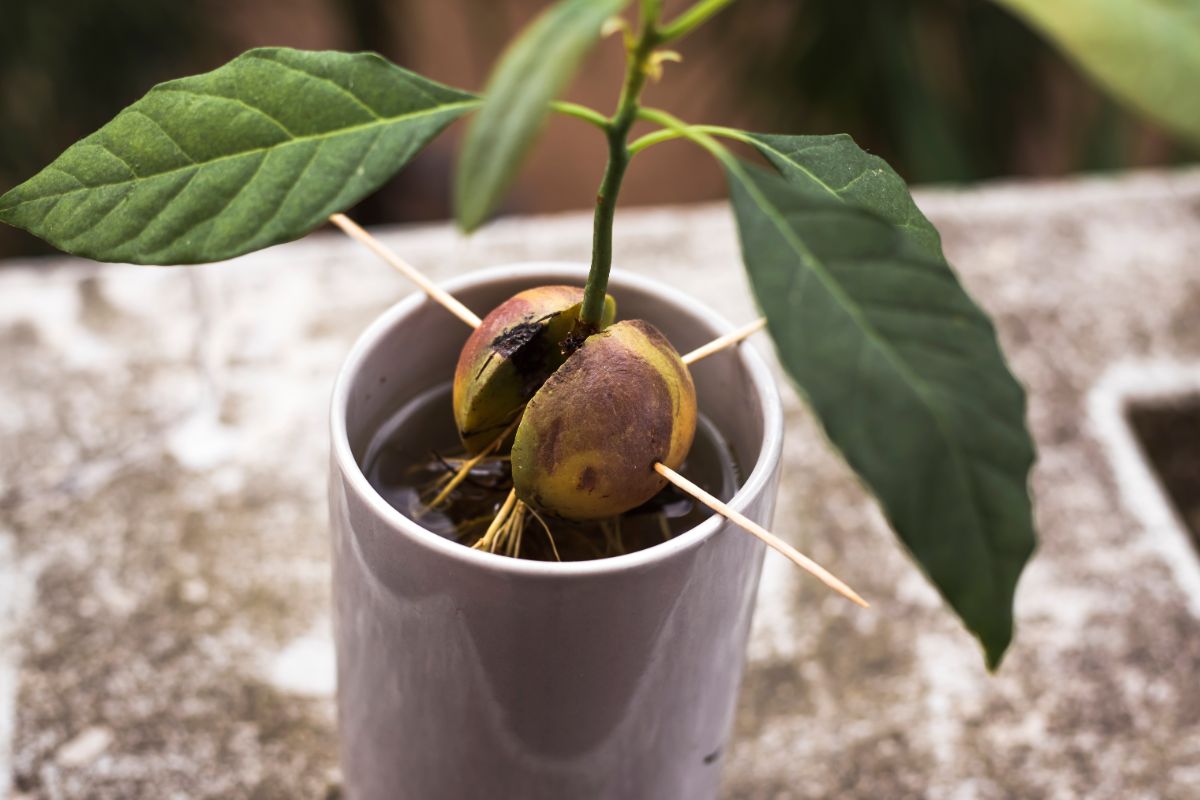
| Plant type: | Avocado |
| Light requirements: | Bright to bright, indirect light |
| Watering requirements: | Moderate |
| Toxic if ingested? | Yes. While fruit is edible for humans, plant is toxic to pets. |
| Special features? | Edible fruit; easy to propagate from food scraps. |
If you like snacking on avocados and guacamole, there’s good news. Avocado trees are really easy to propagate at home from their pits!
For a simple, at-home science experiment, try sprouting avocado pits in a glass of water or pop some pits into your homemade worm composting bin. The rich worm castings will have your plant sprouting in no time.
Avocado trees can grow quite large indoors, and reach well over 20’ tall in nature. However, not all avocados started from pits will produce edible fruit. But, even if your avocado tree never fruits, it still makes for an attractive and low maintenance houseplant!
7. Croton (Codiaeum variegatum)
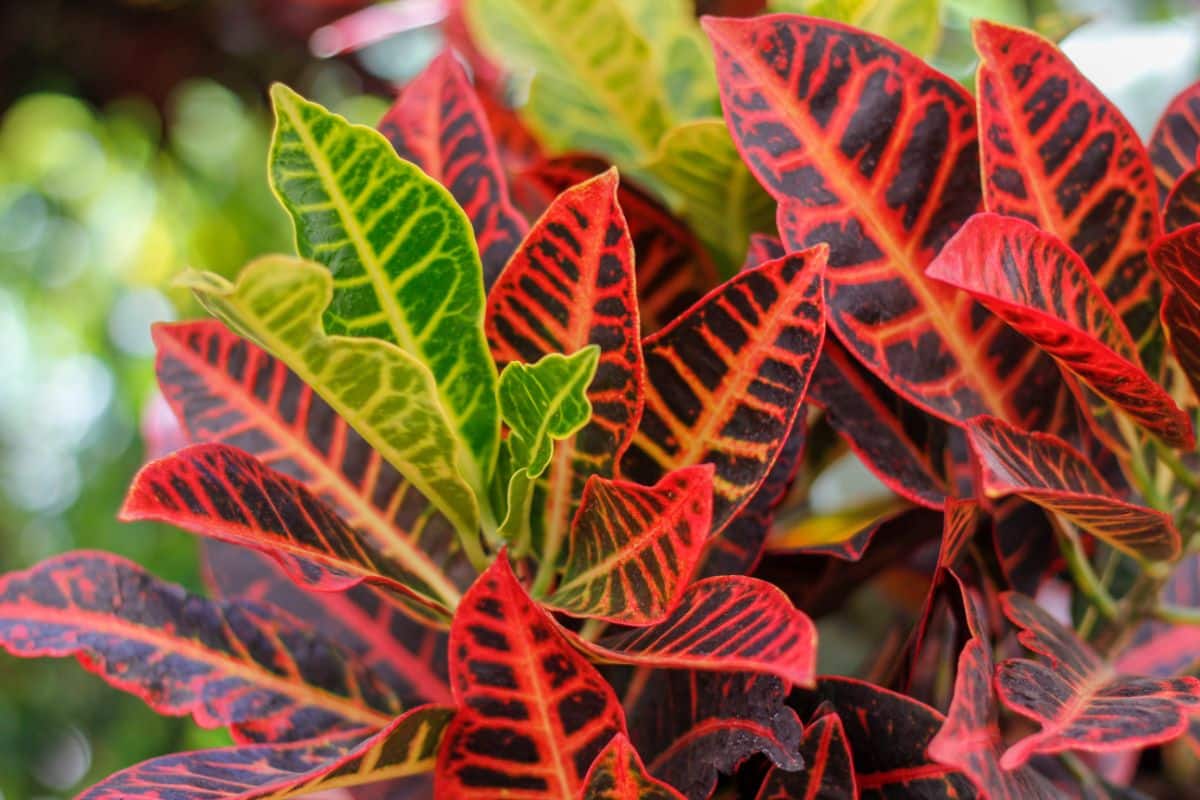
| Plant type: | Croton |
| Light requirements: | Bright light to medium light |
| Watering requirements: | Moderate |
| Toxic if ingested? | Yes |
| Special features? | Colorful leaves. |
Crotons are common sights in outdoor container gardens in autumn; however, they make lovely houseplants too. Known for their highly colored and patterned leaves, there are tons of stunning crotons to choose from. Some popular varieties include ‘Petra,’ ‘Gold Dust,’ and ‘Zanzibar.’
Stems get woodier as the plant grows larger, helping the plant to naturally support itself. Crotons also don’t have high maintenance needs and just need regular weekly watering and bright, indirect light to thrive.
Crotons are quite susceptible to mealybugs and scale though, so be sure to check your plants from time to time for any signs of trouble. Scale insects can hide out on the undersides of leaves making them difficult to spot, so be thorough with your plant inspection.
8. Pitcher plant (Nepenthes spp.)
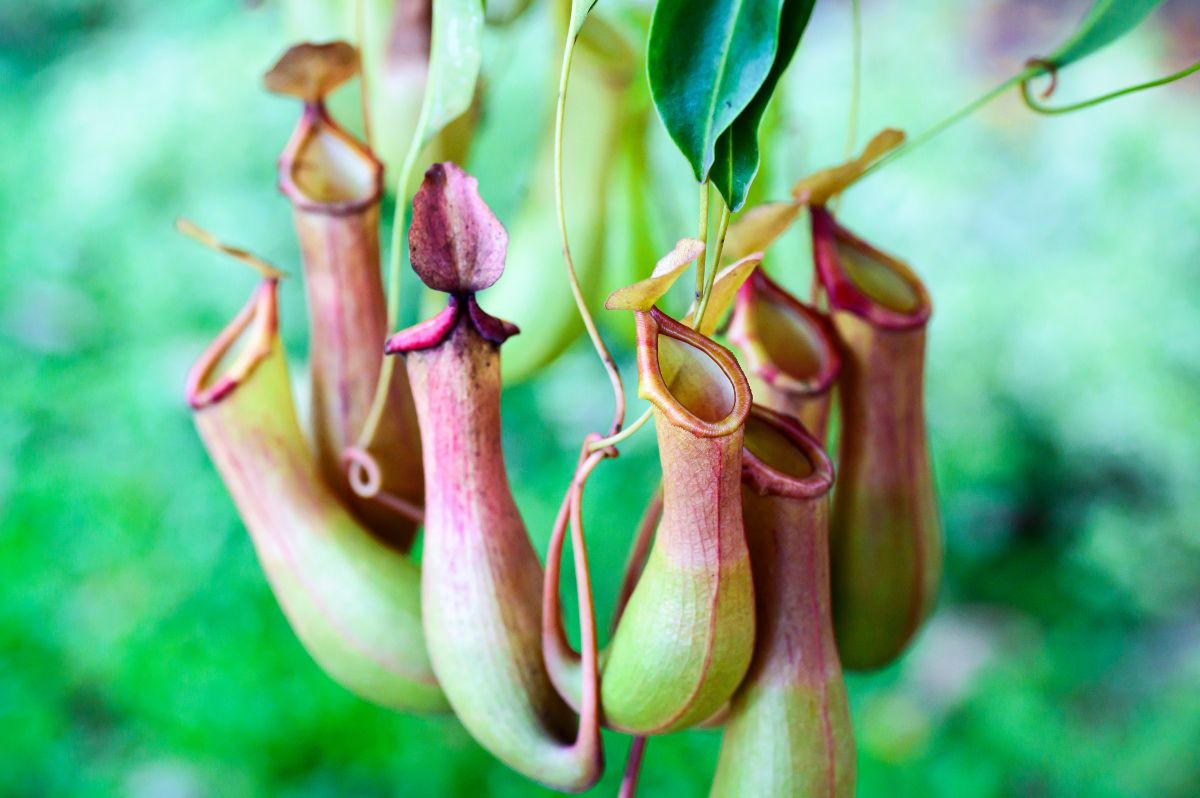
| Plant type: | Pitcher plant |
| Light requirements: | Bright light |
| Watering requirements: | High |
| Toxic if ingested? | No |
| Special features? | Carnivorous plant excels at natural pest control. |
Another carnivorous plant, pitcher plant has a very unique look with tubular pitchers that are specially evolved for capturing houseflies and other insects. With a draping growth habit, pitcher plant is well-suited for hanging basket displays, but it works well as a tabletop plant too.
Like Venus flytraps, pitcher plants are sensitive to chemicals, so never feed them with fertilizers and only water them with distilled or rain water. Preferring consistently moist soil, pitcher plants have higher watering needs than many houseplants, and should be watered every 3 to 4 days. With pitcher plants, balance is key: never let your plant sit in soggy soil, but don’t let soil get completely dry either.
9. Christmas cactus (Schlumbergera spp.)
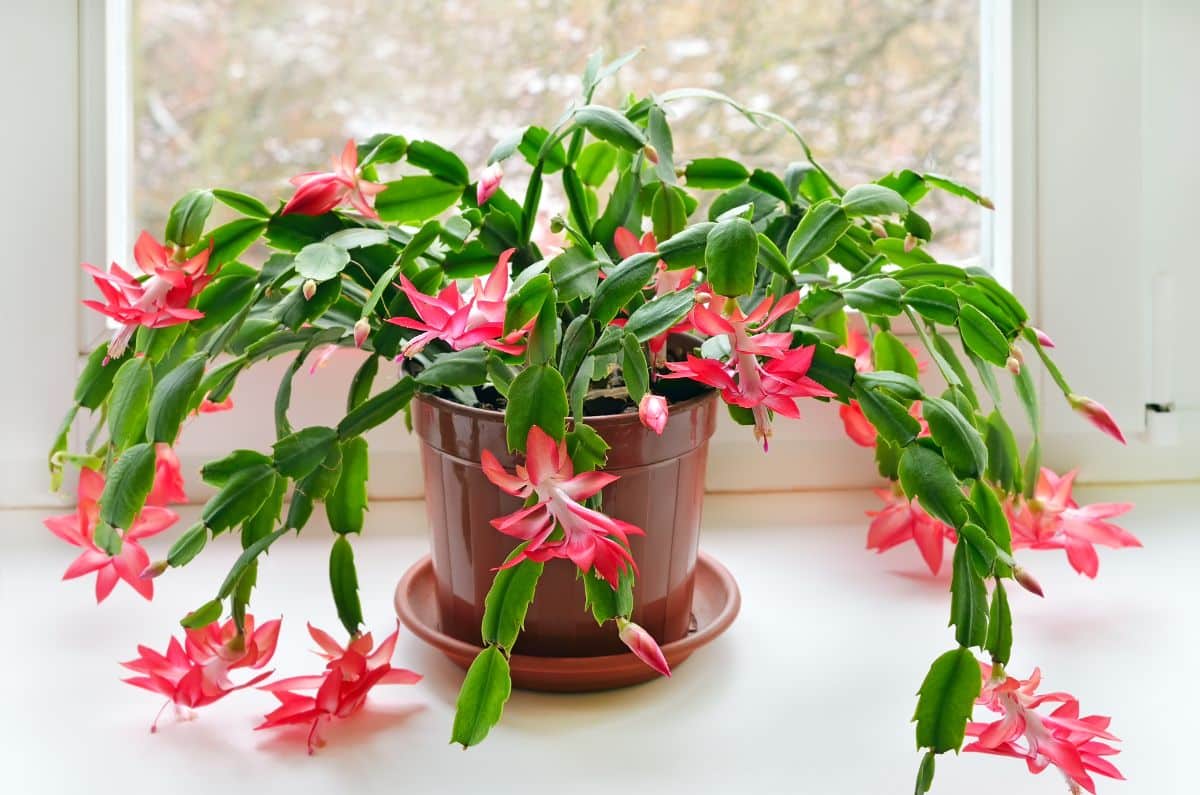
| Plant type: | Christmas cactus |
| Light requirements: | Bright, indirect light |
| Watering requirements: | Low |
| Toxic if ingested? | No |
| Special features? | Propagates easily for sharing; super low maintenance; big, colorful blooms. |
Christmas cacti and their closely related cousin, Thanksgiving cacti, are low maintenance plants that make wonderful starter specimens. With minimal watering needs, you don’t need to worry about accidentally forgetting to water these hardy cacti. Instead, these forgiving plants will reliably reward you with big, tropical-looking blooms in mid-winter.
Named for their bloom times, Christmas and Thanksgiving cacti flower around the holidays, from November to January. Once their flowers fade, the plant’s leaves still lend an interesting texture to houseplant collections and their trailing stems look particularly nice in hanging baskets.
10. Swedish ivy (Plectranthus verticillatus)
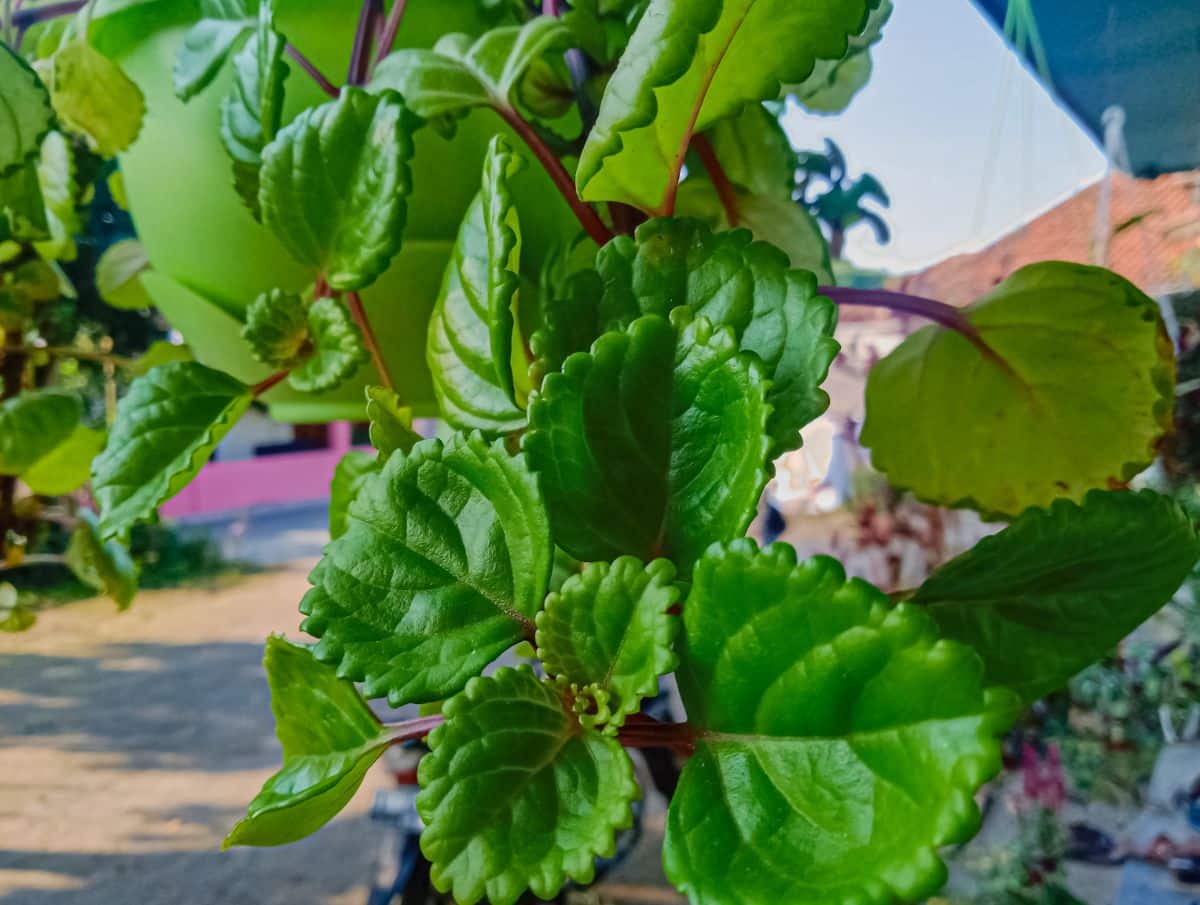
| Plant type: | Swedish ivy |
| Light requirements: | Bright, indirect light to medium light |
| Watering requirements: | Moderate |
| Toxic if ingested? | No |
| Special features? | Propagates easily for sharing. |
Swedish ivy has tender, fleshy stems and glossy, thick leaves with scalloped margins. A distinct looking plant, try Swedish ivy as a tabletop plant, or pot it up in hanging baskets to allow its trailing stems to show in all their beauty.
A truly simple plant to keep, Swedish ivy is known for how easy it is to propagate. If your young gardener loves plants, growing Swedish ivy is a perfect way to get lots more plants for free! Just keep pruning and propagating your Swedish ivy cuttings and watch your houseplant collection grow and grow!
11. Pothos (Epipremnum aureum)
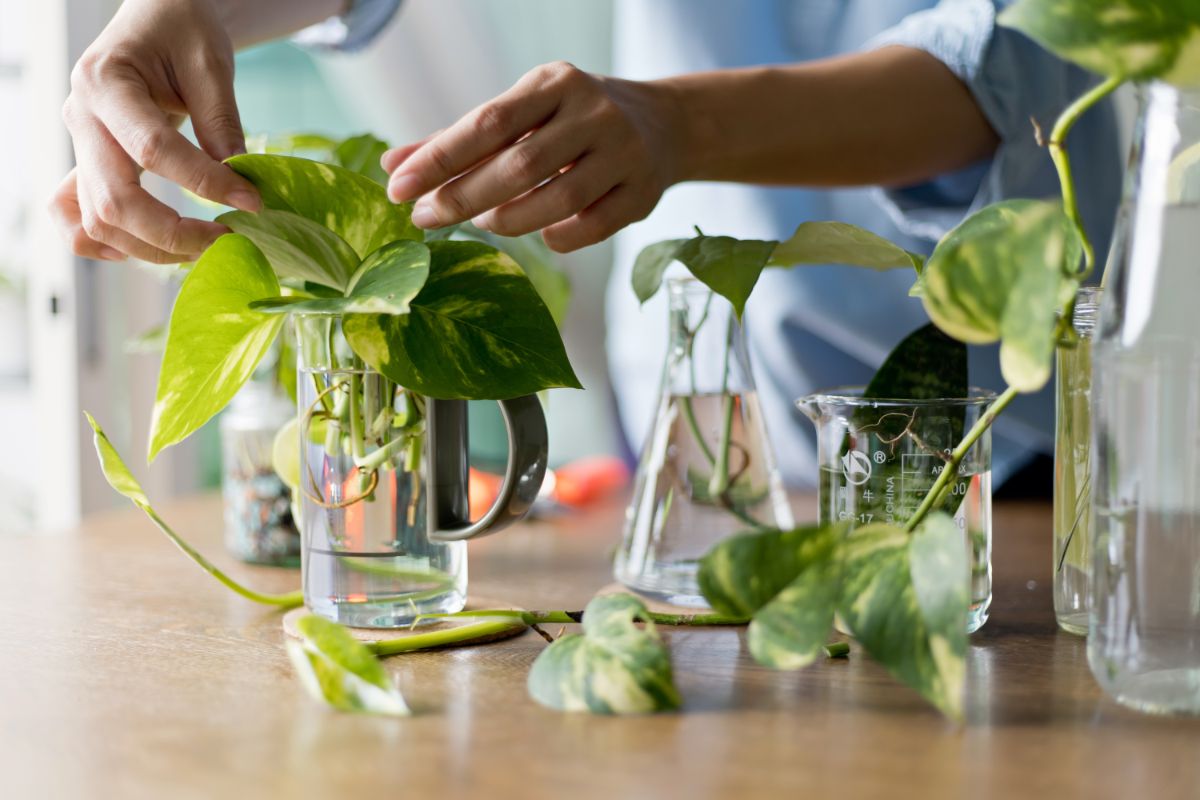
| Plant type: | Pothos |
| Light requirements: | Bright, indirect light to low light |
| Watering requirements: | Moderate |
| Toxic if ingested? | Yes |
| Special features? | Propagates easily for sharing; can be grown in soil or water. |
Like Swedish ivy, pothos is another low maintenance plant that propagates easily in soil or water. In fact, pothos is so easy-going that it is often called “Devil’s ivy” thanks to its nearly indestructible nature.
A vining plant, pothos is perfect for keeping on high shelves or planting in a hanging basket. When properly maintained, vines can easily reach 20’ long; however, if you prefer a bushier looking plant, prune your pothos regularly and root the cuttings in water. Then just pot up your new plant starts in a single pot for a fuller looking plant.
If you like pothos, you’re in luck! There are lots of varieties to choose from including ‘Marble Queen,’ ‘Neon’ and ‘Jade’ pothos.
12. Snake plant (Dracaena trifasciata)
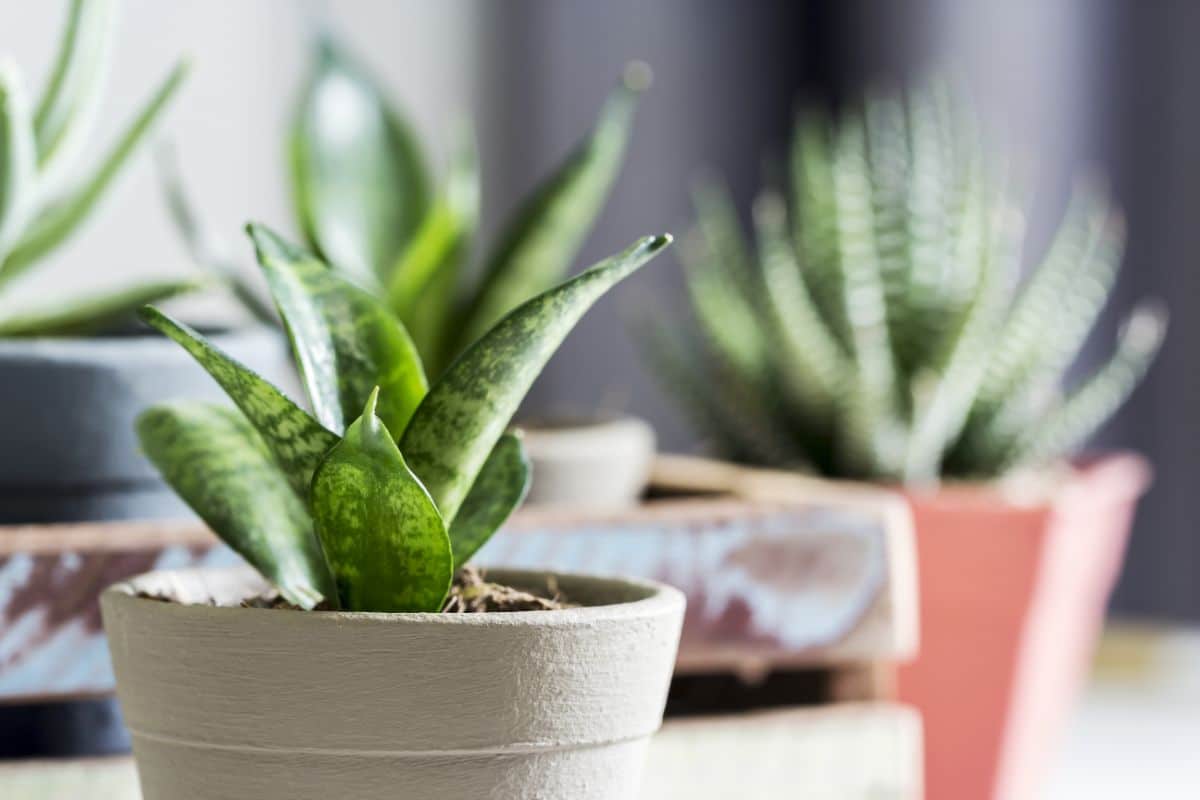
| Plant type: | Snake plant |
| Light requirements: | Bright, indirect light to low light |
| Watering requirements: | Low |
| Toxic if ingested? | Yes |
| Special features? | Super low maintenance. |
One of the easiest plants to keep, snake plants are succulents that thrive on neglect. Preferring bright, indirect light, snake plants can adapt to low light too and can even be grown up to 10’ away from a sunny window, so you have lots of options where to place your plant.
Snake plant leaves are blade-shaped and pointed at one end; however, cylindrical snake plants have rounder leaves for a different look. Leaves are often highly patterned with contrasting shades of green and leaves may also feature yellow stripes of coloration for even more visual interest.
Although snake plants can adapt to low light, if you want to increase the likelihood that your plant flowers, move your plant to a sunny location.
13. Lithops (Lithops spp.)
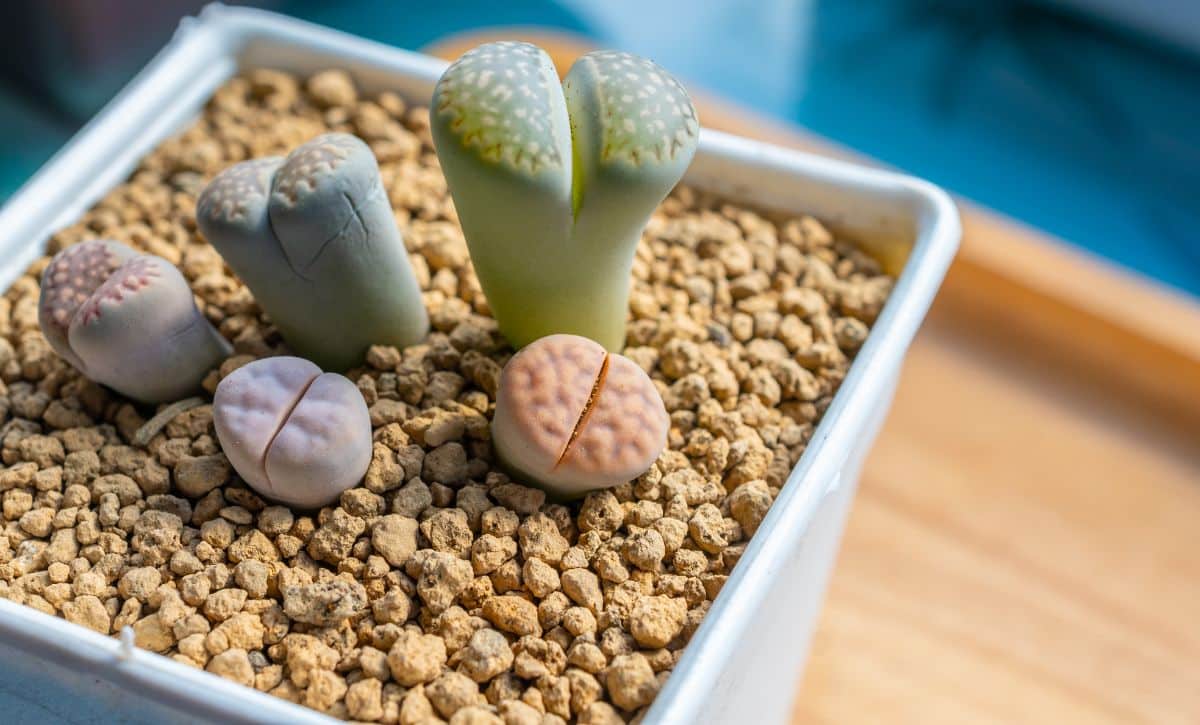
| Plant type: | Lithops |
| Light requirements: | Bright light |
| Watering requirements: | Low |
| Toxic if ingested? | No |
| Special features? | Super low maintenance. |
Also known as “living stones,” lithops are oddball plants that are totally unique. Each lithops plant consists of two rounded and fleshy leaves, which have evolved for water storage. These leaves come in blues, greens and browns and have a highly patterned surface, helping the plant to blend in with nearby stones.
Native to South Africa, these hardy plants require little watering and lots of bright light. When properly cared for, lithops will reward you with a single, daisy-like flower that emerges from between its succulent leaves for a perfect pop of color.
14. Dwarf citrus
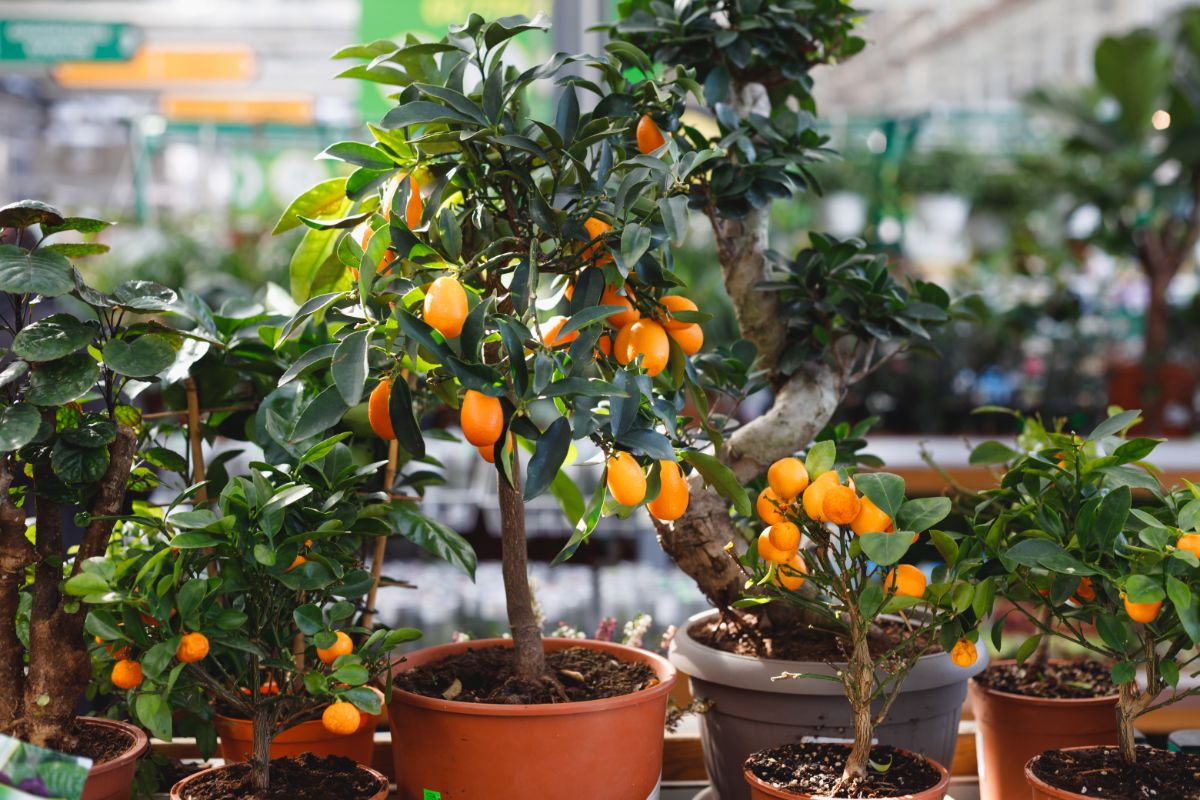
| Plant type: | Dwarf citrus |
| Light requirements: | Bright light |
| Watering requirements: | Moderate |
| Toxic if ingested? | Yes. While fruit is edible for humans, plant is toxic to pets. |
| Special features? | Edible fruit. |
Many citrus trees come in dwarf varieties that are just the right size for keeping indoors. From kumquats to Meyer lemon trees, these mini trees are small enough that they won’t overwhelm your space, but large enough to produce a surprising amount of fresh, homegrown citrus for snacks and homemade lemonade!
Many dwarf citrus trees come with variegated leaves to give even more color to your collection. They also don’t need lots of maintenance, but they do best with bright light and an organic fertilizer specially formulated for citrus plants. Your plants may also benefit from a boost of extra humidity, so try keeping your plants on a pebble tray or near a humidifier.
15. Old man cactus (Cephalocereus senilis)
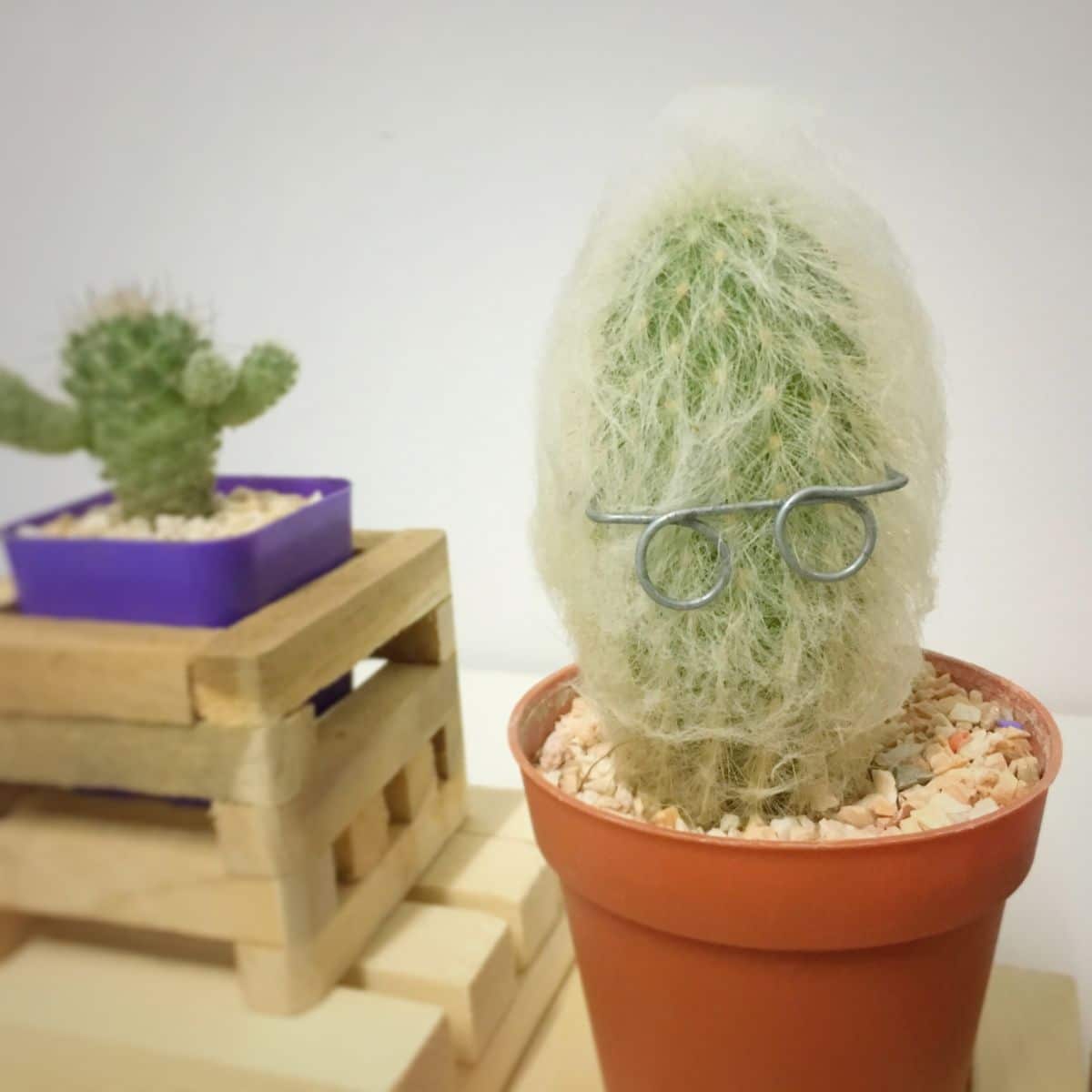
| Plant type: | Old man cactus |
| Light requirements: | Bright light |
| Watering requirements: | Low |
| Toxic if ingested? | No |
| Special features? | Super low maintenance. |
While there are lots of delightful cactus species to try, one that always seems to please young gardeners is the old man cactus. This cactus has a fun name, but that’s not all. It also has a very distinct fuzzy appearance that makes it a standout plant for any indoor garden.
Unlike other cacti that have sharp spines, the spines of old man cactus have modified and changed into the fine, white hairs that this plant is known for. But even though it may look soft, many of these cacti still have small spines underneath all that fuzz, so be sure to protect small hands when repotting this spiky plant.
16. Nerve plant (Fittonia albivenis)
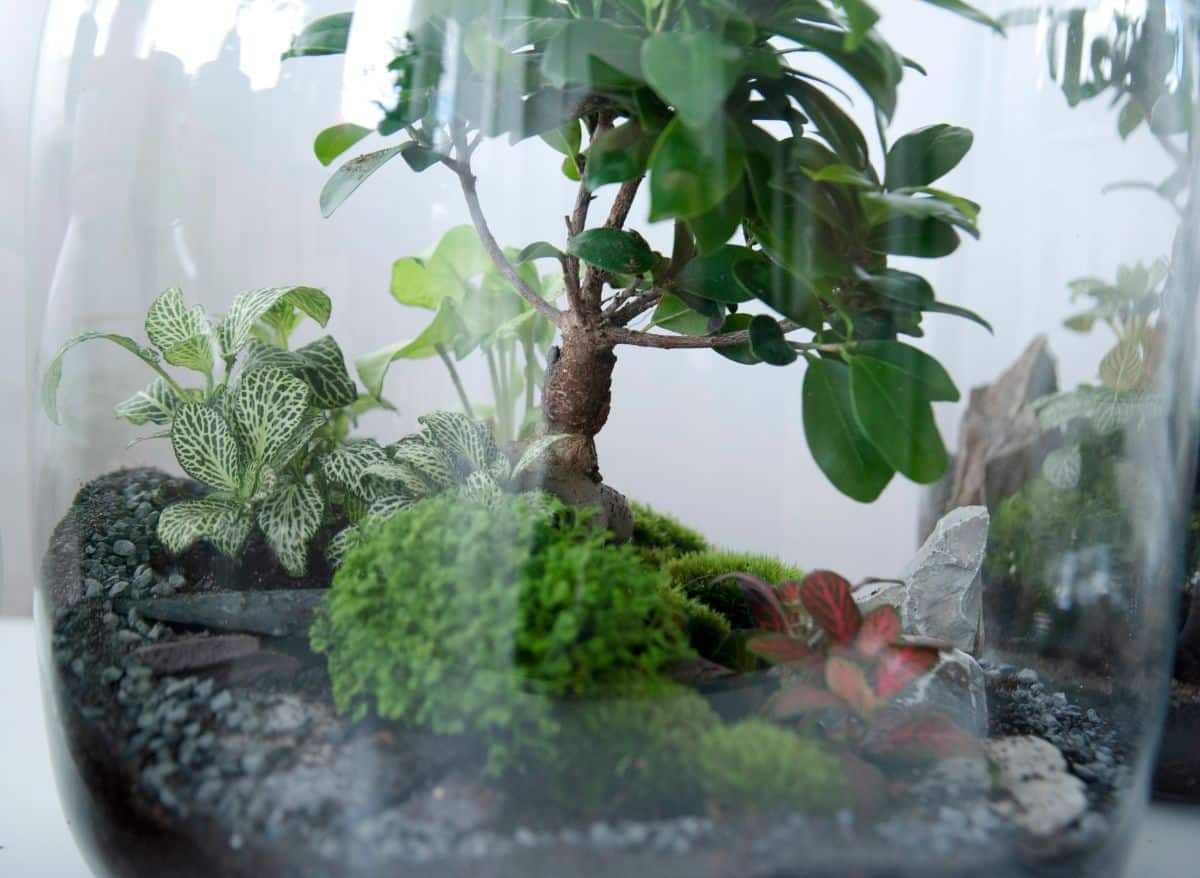
| Plant type: | Nerve plant |
| Light requirements: | Medium to low light |
| Watering requirements: | High |
| Toxic if ingested? | No |
| Special features? | Perfect for terrariums. |
Nerve plant can be a tricky plant to keep happy, but it’s easy enough if you understand the basics of this plant. Nerve plants like a lot of moisture and humidity and will rapidly and dramatically wilt if their soil is allowed to dry out. While this can look startling, plants usually recover quickly when watered.
To keep your nerve plants from drying out, adding a humidifier or pebble tray to your setup is recommended. But, if you really want to grow happy nerve plants, try potting up this beauty in an indoor terrarium. This plant’s colorful leaves will look attractive under glass, and the added protection will keep soil from drying out too quickly.
17. Spider plant (Chlorophytum comosum)
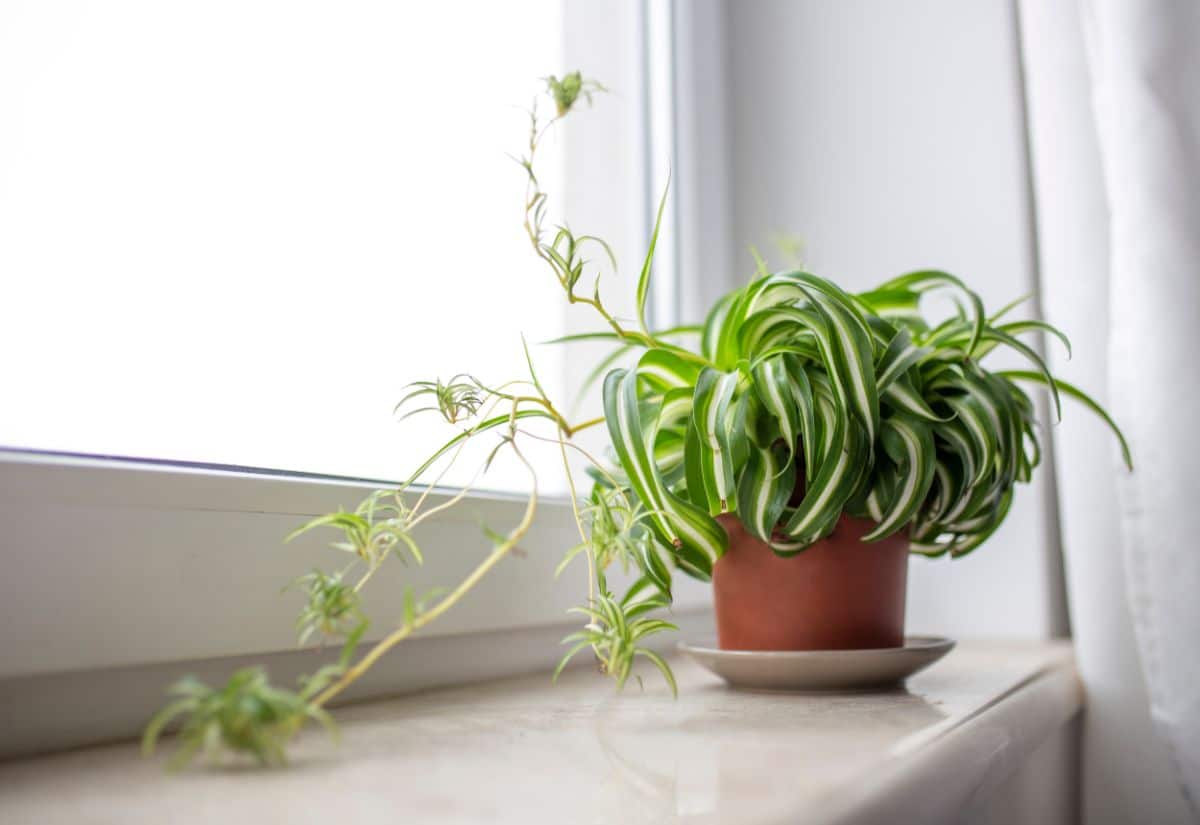
| Plant type: | Spider plant |
| Light requirements: | Bright, indirect light |
| Watering requirements: | Moderate |
| Toxic if ingested? | No |
| Special features? | Propagates easily for sharing. |
One of the easiest plants to grow, there’s just so many reasons to love spider plants. With simple care requirements, spider plants are adaptable and perfect for beginning gardeners. Their airy appearance also makes them well-suited for hanging planters, but they make stunning tabletop plants too.
Spider plants come in both solid green and variegated green and white colorings for more variety. When mature, plants bloom small white flowers that develop into baby spider plants or “spiderettes.” These spiderettes are easy to propagate to make more plants, or you can allow them to grow on the parent plant for more texture.
18. Herbs
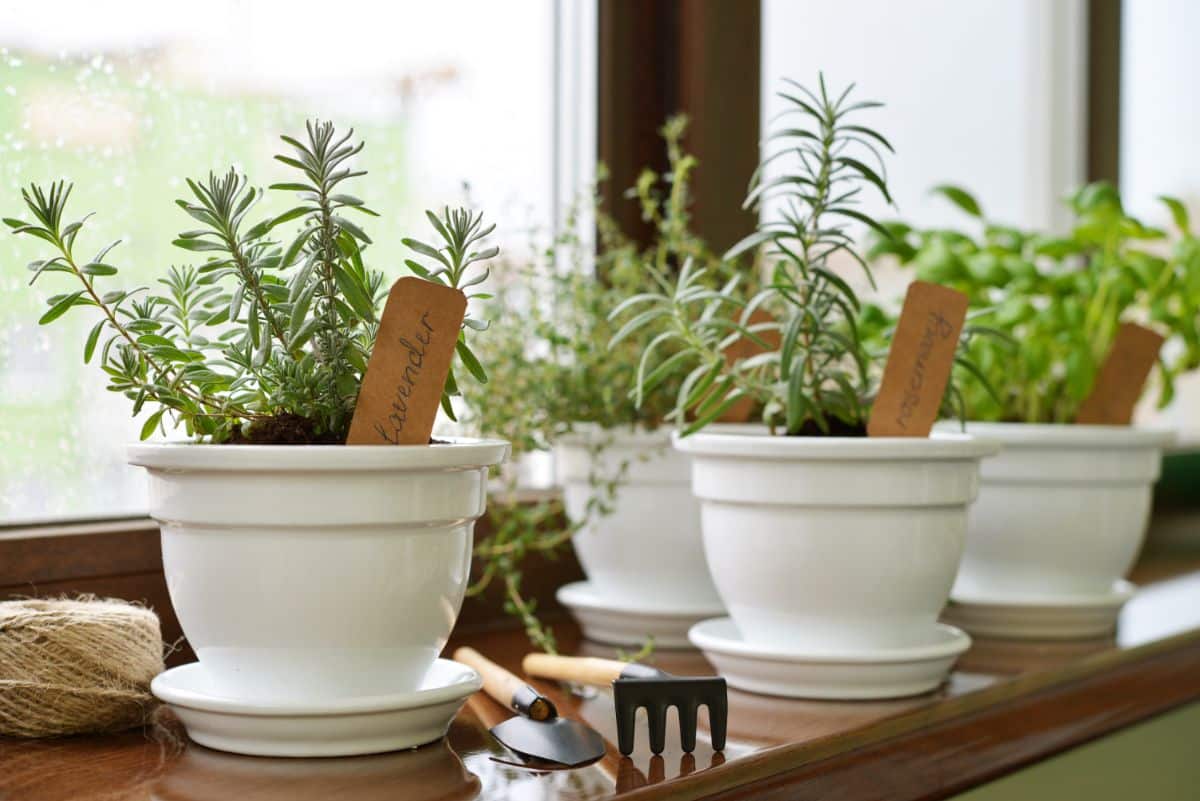
| Plant type: | Herbs |
| Light requirements: | Bright light |
| Watering requirements: | Moderate |
| Toxic if ingested? | No |
| Special features? | Edible; fun for beginning cooks! |
From cilantro to basil, there are lots of edible herbs that grow well indoors and can be very rewarding plants for young gardeners to keep. Not only are these plants low maintenance, but they grow quickly and produce lots of tasty fresh herbs to add to dishes. If you have a budding home chef at home, keeping a small kitchen herb garden is an easy way to encourage their interest.
Most standard culinary herbs can be grown indoors, but many of these plants have higher than normal humidity needs. This is because indoor humidity levels tend to be lower than outdoor humidity levels, especially in the winter. To prevent crispy leaves, try keeping your herbs on a pebble tray or add a humidifier to your setup.
For delicious herbs to try indoors, consider:
- Basil
- Cilantro
- Thyme
- Rosemary
- Mint
- Chamomile
- Lavender
- Parsley
- Chives
Frequently asked questions
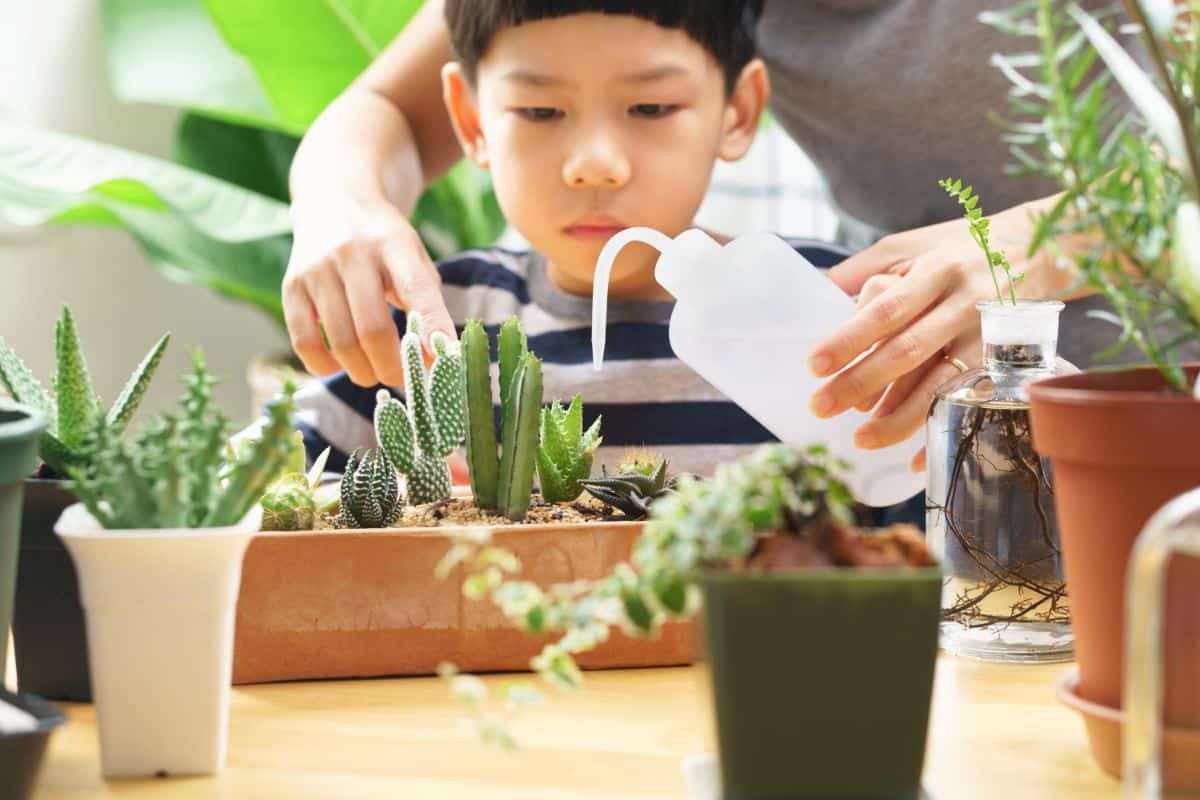
Low maintenance and adaptable plants are the best choices for young gardeners. Due to their simple care requirements, some of the best plants for the job are often cacti and succulents, which need little watering. However, easy-care tropicals, like pothos and Swedish ivy, make good choices too.
If you have youngsters in your home, the safest plants to keep are non-toxic plants without sharp spines. Some of the safest plants for young plant keepers include pitcher plants, Venus flytraps and Gerbera daisies.
Depending on your child’s interest, there are lots of houseplants that would make wonderful additions to bedrooms and playrooms. For lots of color, try out Gerbera daisies and Christmas cacti. Or, for air purifying benefits, snake plants and spider plants are hard to beat.
Many popular houseplants are toxic if ingested, so it’s a good idea to research plants carefully before bringing any new species into your home. If in doubt, the ASPCA has a comprehensive list of toxic and non-toxic houseplants.
Summary

Houseplants are highly collectible and super rewarding to keep, regardless of your age. But certain plants are particularly appealing for young growers and new gardeners.
Thanks to their easy care requirements and other unique features, the plants in this guide are some of the best species to try if you have a budding botanist at home or your kids simply love gardening. From the basics of plant propagation to the unique adaptations of carnivorous plants, there’s so much to learn from indoor plants!
If you liked this article, check out our piece on creating DIY mosaic stepping stones for other creative ways to encourage young gardeners!

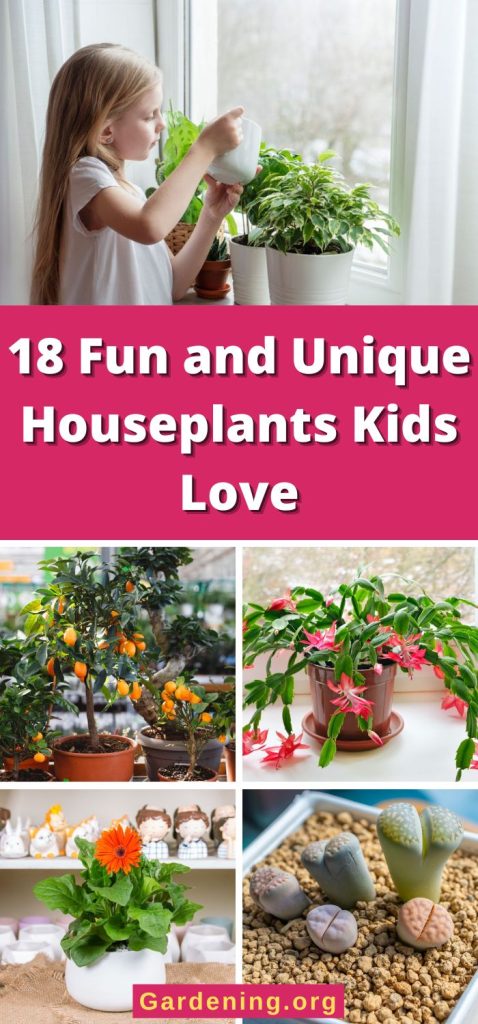
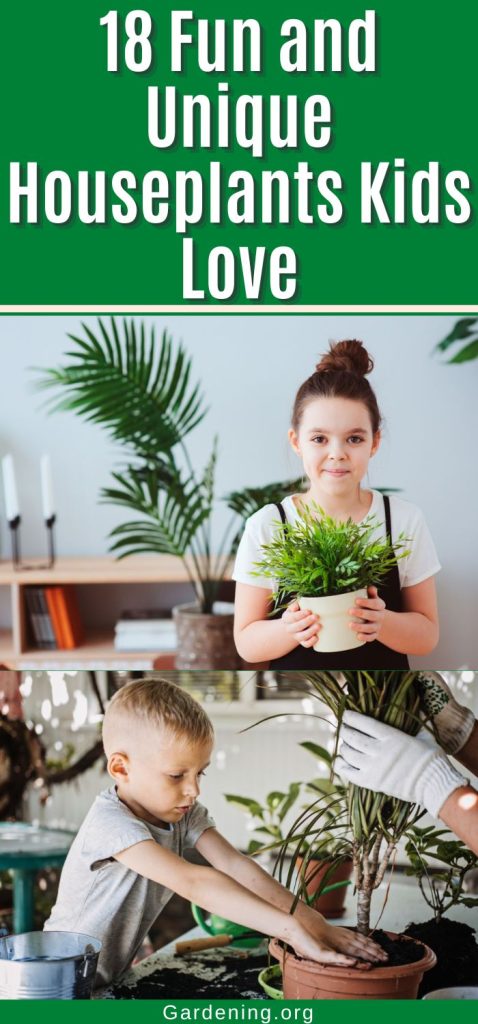
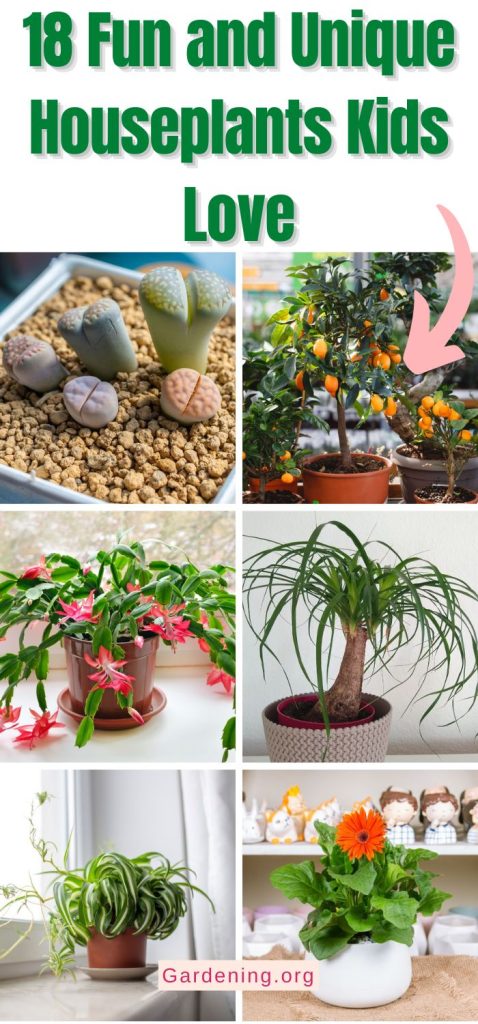
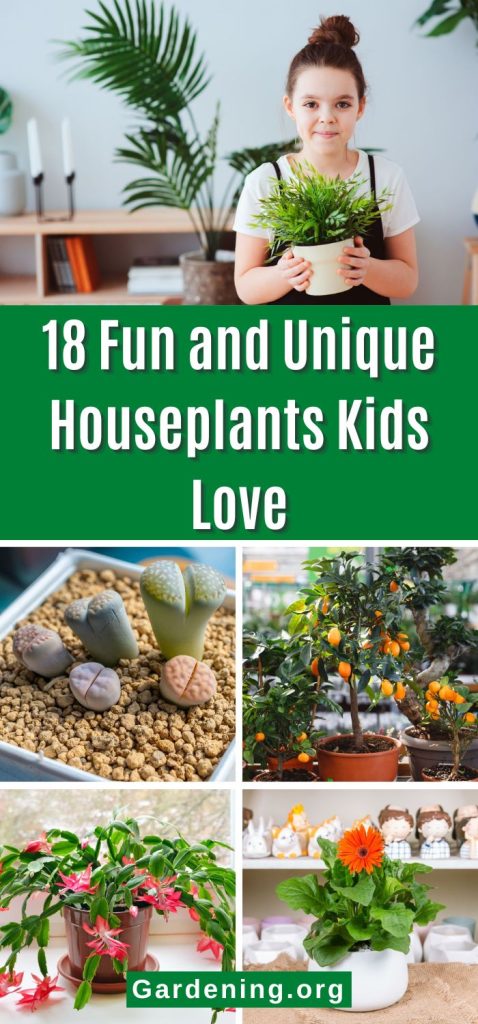
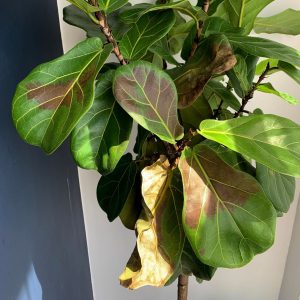
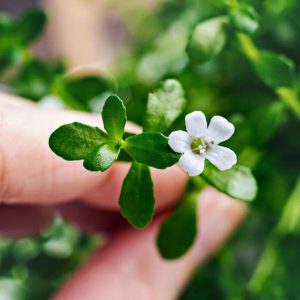


Leave a Reply